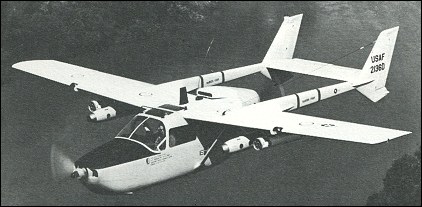 |
Cessna Model 336 / 337 Skymaster / O-21961 |  |
| SIX-SEAT CABIN MONOPLANE | Virtual Aircraft Museum / USA / Cessna |
 |
The push-pull concept, with engines driving one tractor and one pusher propeller, was adopted by Cessna in the late 1950s for a light, low cost, easy-to-fly twin, and one obvious advantage over a normal twin layout was that, in the event of an engine failure, there would be no asymmetric thrust problems. On 28 February 1961, the prototype Cessna Model 336 Skymaster flew and FAA certification followed 15 months later, with deliveries beginning in May 1963. Powered by two 157kW Continental IO-360-A engines, the new aeroplane was a four-seater with fixed tricycle landing gear, although - alternative seating arrangements for up to six were available. However, fixed landing gear on light twins was becoming passe, and after 195 Model 336s had been built the type was replaced on the production line in early 1965 by the Model 337 Super Skymaster with retractable landing gear. Additional baggage space was available in an optional glassfibre pack with a capacity of 136kg, which could be carried beneath the fuselage. In 1969, Reims Aviation in France began licence assembly of the Model 337, with primary structures supplied by Cessna and Continental engines built in the UK under licence by Rolls-Royce. The US and French production lines continued in parallel, the French versions being classified Reims F337. The name Milirole was applied to the basic unpressurised F337 for a short time. Since 1974 Reims have developed a special unpressurised STOL version, designated FTB337, which can be provided with a wide range of equipment to make it suitable for such duties as maritime or overland patrol and rescue. Detail improvements continued each year, and a turbocharged version, the Model 337 Turbo-System Super Skymaster, was introduced in 1970, but the prototype of a pressurised T337 Skymaster, powered by 168kW Continental TSIO-360 engines, flew in July 1971 (the word Super had then been dropped), and deliveries began the following May. Military versions designated O-2 were supplied to the US Air Force for various missions, including forward air control, for experience in Vietnam suggested that such sorties could be made more effective with FAC aircraft operated by a pilot and Forward Air Navigator (FAN), the latter being able to concentrate on the FAC mission without having to fly the aircraft. Cessna's Model 337 was selected 'off the shelf' in late 1966 as being ideal for this role, and equipped with four under-wing pylons to carry flares, rockets and light ordnance such as a 7.62mm Minigun pack. 501 were supplied to the USAF designated O-2A. In addition, a version equipped for psychological warfare missions entered USAF service under the designation O-2B This carried a powerful air-to-ground broadcasting system using three 600-watt amplifiers and a battery of highly directional speakers. Total procurement of O-2B aircraft amounted to 31. Both versions car-ried advanced nav/com systems. Twelve O-2As were supplied to the Imperial Iranian air force in early 1970. A twin-turboprop O-2T/O-2TT did not proceed beyond USAF evaluation. Production of the Model 337 series by Cessna ended in mid-1980 by which time 1,821 Model 337s, 313 pressurised Model 337s and 544 military O-2s had been delivered. French production by Reims Aviation totalled 66 Model F337s, 27 F337Ps and 61 FTB337s.
|  COMPANY PROFILE | ||||||||||||||||||||||||||||||||||||||||||||||||||||||
 |

|

